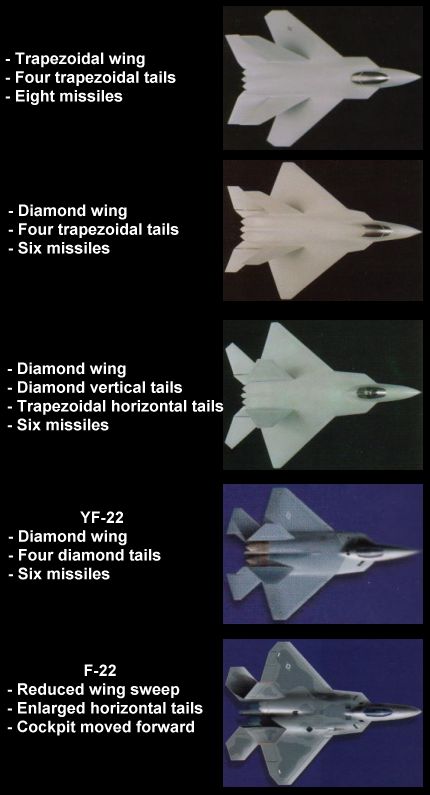|
||||||||||
|
|
||||||||||
|
||||||||||
|
|
||||||||||
What became the F-22 project officially began in 1981 when the US Air Force Aeronautical Systems Division, or ASD, put out a request for concepts for an advanced tactical fighter (ATF) to replace the F-15 Eagle. Key to the desired replacement were the application of low-observables (or stealth) technology, the ability to supercruise (or fly at supersonic speeds without using afterburners), maneuverability, and short-takeoff and landing (STOL) capability. Lockheed believed high speed and the ability to carry long-range weapons were key to the ATF mission, so its original concept was derived from the YF-12A, forerunner of the SR-71 Blackbird. Likewise, Boeing also focused on high speed but addressed stealth by including internal weapons bays. General Dynamics produced two concepts. The first was a fairly conventional design but included some advanced stealth treatments and avionics concepts. The second was a flying wing concept that eventually led to the Navy's A-12 Avenger.
Some examples of early concepts include this relatively conventional design as well as a vehicle called the Missileer armed with several long-range air-to-air missiles. Ideas from General Dynamics included such proposals as a V/STOL design known as the Jiminy Cricket and a stealth design dubbed the Marshmallow.
In September 1983, contracts were awarded to each of the major manufacturers of the time (Boeing, General Dynamics, Grumman, Lockheed, McDonnell Douglas, Northrop, and Rockwell) asking each to define concept vehicles and identify key skills, abilities, and technologies needed to develop such a fighter. Convinced by these studies that an ATF was practical, the Air Force subsequently issued a request for proposals (RFP) in September 1985. Because Lockheed's YF-12 concept had been rated last among the contenders in the concept phase, the company decided to start over from scratch and develop a new design based on the F-117 stealth fighter. However, the faceted surface approach used on the F-117 had already lost Lockheed contracts to develop the B-2 bomber and the Navy's A-12, so engineers began exploring curved shapes, building several test shapes and evaluating them on the company's radar range. The resulting design featured a highly flared nose, relatively conventional wing, and canted vertical tails.

Boeing engineers, meanwhile, designed their concept around the weapons bay and used their skills in avionics and composites to meet the ATF requirements. Boeing chose a V-tail design over four tails to improve stealth and reduce weight. General Dynamics engineers finally settled on a semi-tailless approach matching a large wing full of sawtooths with a single vertical tail.
As the dem/val phase of the competition drew to a close, the Air Force encouraged teaming partnerships between the various competitors so the final winning designs would beneift from the best the industry had to offer. Thus, McDonnell Douglas became a partner with Northrop, and Boeing and General Dynamics teamed with Lockheed. These companies, along with Grumman and Rockwell, responded with ATF proposals on 28 July 1986. After a three month review, the Air Force announced Lockheed and Northrop had developed the best ATF concepts, and each was awarded $691 million to develop, build, and flight test prototypes, the Lockheed YF-22 and Northrop YF-23. Though Lockheed's winning proposal had evolved slightly during those three months, it was the company's understanding of stealth and its impact on operations as well as the company's plan to reduce risk and keep costs under control that won the contract rather than the specific characteristics of their design.
Immediately after the Air Force announcement, representatives of Boeing, GD, and Lockheed met and each spent two hours describing their ATF concepts. From these discussions, the design team identified the strengths of each concept and blended them together to create a baseline design. Using this baseline as a springboard, engineers at all three companies began an intense series of trade studies to identify the best overall configuration meeting all the design requirements. These iterations looked at traditional trapezoidal wings vs. the diamond wing eventually selected, using horizontal and vertical tails vs. combined V-tails, various engine inlets, and a main-bay payload of six missiles vs. eight. The below graphic gives a better idea of how the final F-22 configuration evolved over time.

Although this effort yielded a far superior design in the end, the final concepts leading up to the YF-22 were still unable to meet the Air Force requirements for both short takeoff and landing and supercruise simultaneously. Once the Air Force dropped the STOL requirement, the aft portion of the aircraft was redesigned allowing significant reductions in drag and making supercruising possible.
Following a decade of concept studies, design reviews, and construction, both the Lockheed and Northrop ATF
prototypes first flew in 1990. While Northrop had put greater emphasis on stealth, the YF-22's greater
maneuverability and better designed weapons bay are considered the reasons it was selected over the YF-23. In
addition, there were some questions about Northrop's financial health and ability to mitigate risk. While
the competition was underway, engineers at Lockheed, Boeing, and General Dynamics had continued to refine the
YF-22 prototype taking into account lessons learned from the flight test program. Thus, the production F-22,
first flown in 1997, includes a number of modifications intended to improve aircraft performance and
operability. Despite budget cuts and close Congressional scrutiny, the F-22 is due to enter service in 2005.
- answer by Jeff Scott, 8 April 2001
Related Topics:
What type of airfoil is used on the F-22 Raptor? What is its name?
I want to know more about the F-14 replacement. I saw a picture of a swing wing F-22.
Read More Articles:


|
Aircraft | Design | Ask Us | Shop | Search |

|
|
| About Us | Contact Us | Copyright © 1997- | |||
|
|
|||